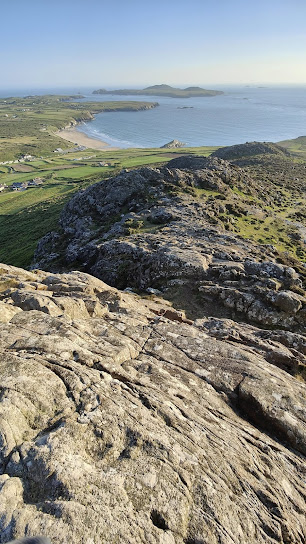Our old friend Tim Daw continues his one-man defence of the bluestone quarrymen, mostly on his blog, which I ignore for most of the time. He clearly likes to follow my utterances and writings, and posts rather frequent and very aggressive ripostes, while in some cases being very reluctant indeed to mention me by name. Weird, that. Maybe he is afraid I might sue him.......... he need have no concerns on that score, since (unlike some of his cronies) I actually believe in the merits of open academic debate.
But the one-man hit squad is now behaving in a way which can only be described as bizarre. First, back in March he hired an anonymous "referee" to review my two papers on the Limeslade erratic, and published it on his blog, here:
https://www.sarsen.org/2025/03/peer-reviewing-john-2025.html
Anonymous peer reviews in circumstances such as these are of course completely worthless, and I refuse to engage with this one. If a reviewer does not wish to publish his / her name alongside disparaging and insulting comments, why should anybody take them seriously? Shame on him / her for taking part in this grubby little stunt. Maybe Tim wrote the review himself in spite of denying that he had anything to do with it? Maybe it was written by a committee of aggrieved academics (Ixer, Bevins and Parker Pearson come to mind) and then put in the public domain with the pretence that it represented the opinion of somebody who is an "independent expert" in the field? Who knows what goes on in the shadows..........
Then in April 2025 Tim published an anonymous rant entitled: "A Critical Review of "Carn Goedog on Mynydd Preseli Was Not the Site of a Bluestone Megalith Quarry": Another Glacial Fantasy Masquerading as Scholarship."
https://www.sarsen.org/2025/04/a-critical-review-of-carn-goedog-on.html
Again there was no mention as to the name of the author, who spat out a great deal of bile beneath a cloak of anonymity.
Then Tim wrote a riposte on the matter of far-travelled Bristol Channel coastal erratics, referring to my Limeslade erratic paper published in QN 162 (June 2024). Tim's piece was clearly designed to show that the "high level erratics" cannot have been carried by glacier ice but must have been transported on ice floes and carried uphill by human beings. (The ice floe transport idea is of course also promoted by James Scourse and others in previous publications.) The latest blog post is here:
https://www.sarsen.org/search?updated-max=2025-04-21T13:49:00%2B01:00&max-results=7&start=7&by-date=false
and it refers to an "important article" -- written modestly by himself -- on the Researchgate web site:
https://www.researchgate.net/publication/390953838_Critical_Analysis_of_Claims_Regarding_High-Level_Glacial_Erratics_in_the_Bristol_Channel_and_the_Implication_for_the_Glacial_Transport_Theory_of_Stonehenge_Bluestones?channel=doi&linkId=6804ba5cdf0e3f544f42e7c7&showFulltext=true
This is referred to as a "preprint", which means of course that it has not been reviewed or assessed for quality. Suffice to say that it is a very strange piece of work, filled with misunderstandings and unwarranted assumptions and obsessed with the 100m contour. Boulders and erratic fragments found over that altitude are deemed to be worthy of consideration, and erratics beneath it are discounted as irrelevant. The important work of Madgett, Inglis and others is cited but effectively discounted, as is my article in QN 164 (February 2025). The reference list is strongly biased and selective. There is no mention of the work of Bennett et al (2024), who are in no doubt that the ice of the Irish Sea Ice Stream did affect the coasts on the southern shore of the Bristol Channel.
I just cannot understand what Tim is on about here; why is he so obsessed with demonstrating that flowing glacier ice did not affect the Bristol Channel coasts, when everybody knows that the evidence demonstrates otherwise?
Then, also in April, Tim published three further reviews of my papers on Rhosyfelin, Carn Goedog and Waun Mawn:
https://www.sarsen.org/2025/04/a-review-of-brian-johns-2015-paper.html
https://www.sarsen.org/2025/04/a-review-of-brian-johns-2024-paper.html
https://www.sarsen.org/2025/04/a-review-of-carn-goedog-on-mynydd.html
No authorship is revealed for any of these weird critiques, and so they can be dismissed without further ado. They might of course have beern generated through some AI programme, but that does mot make them any more meaningful, since we do not have any idea what prompts and editing adjustments there might have been, and we have no sight of any of the reviews that might have been commissioned from the same AI source for articles written by MPP and his team. Now THAT would be an interesting exercise...........
The AI question comes up again in a very strange article published in Researchgate with the joint authors shown as Tim Daw and "Groc":
https://www.researchgate.net/publication/390662999_A_Review_of_Brian_John's_Three_Papers_on_Bluestone_Quarrying_Sites
It turns out that Groc is an AI bot, and that his (???) contribution was prompted and edited by Tim. In other words, it is a meaningless exercise which has no value as a piece of independent and unbiased research.
What on earth is this article doing on the Researchgate web site? I am contacting the moderators to check out what their policy on AI might be, and to ask for the removal of something that makes no pretence at all to represent original scientific thought or process.
So there we are then. Tim's mission of character assassination continues at an accelerating pace, but at least he has the good grace to use his own name. But it's sad to see that he now has to resort to AI to do his thinking for him. As for those who use Tim's blog site to publish abusive rants directed at me personally while sheltering beneath a cloak of anonymity, they are beneath contempt. And shame on Tim for allowing it to happen.
.



























